
Bordeaux Wine Office
The region has not always been out of fashion. In the Middle Ages, at a time when the Médoc was mainly marsh, moorland, and forests, Graves was renowned for its Claret, a light wine much enjoyed by the English and shipped in large quantities to England. Château Haut-Brion, Graves' most famous estate, was the first Bordeaux Château to achieve international recognition. Its 1784 vintage was one of Thomas Jefferson's favorite wines. In the 1855 classification, Château Haut-Brion was ranked First Growth along with Château Lafite-Rothschild, Château Latour, and Château Margaux. In 1959, Graves created its own classification system that recognized 13 Châteaux for their red wines and 8 Châteaux for their white wines.
Graves gets its name from the soil, a mix of gravels, clay and sand carried out by the river. The gravel pebbles work as thermoregulator: during the day, they reflect the sun and accumulate the heat that they radiate back to the vines at night. The soil is also very porous, which creates a semi-arid condition producing low-vigor vines.
It is the only region in Bordeaux that is renowned for both its red and white wines. Two third of Graves wines are red and made primarily from Cabernet-Sauvignon with smaller amounts of Merlot and Cabernet Franc. The white wines, generally fresh, fruity, and dry, are among the best white wines in Bordeaux. Usually vinified in oak, they are produced from three grape varieties, Sauvignon Blanc, Sémillon, and Muscadelle.
Tasting the white wines Our first wine was the 2003 Les Plantiers du Haut-Brion. A blend of Sauvignon Blanc and Sémillon, this is the second white label of Château Haut-Brion. The wine was delicious and my favorite white wine. It had a pale yellow color and an attractive nose of pear, apple, and honey. On the palate, it had a fat mouthfeel with citrus and butterscotch flavors and a nice long finish.
Our first wine was the 2003 Les Plantiers du Haut-Brion. A blend of Sauvignon Blanc and Sémillon, this is the second white label of Château Haut-Brion. The wine was delicious and my favorite white wine. It had a pale yellow color and an attractive nose of pear, apple, and honey. On the palate, it had a fat mouthfeel with citrus and butterscotch flavors and a nice long finish.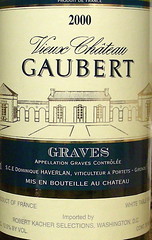 The next wine was the 2000 Vieux Château Gaubert Blanc. The Vieux Château Gaubert, from the Graves appellation, is considered to be a good value both in white and red. The white wine, a blend of 45% Sauvignon Blanc, 30% Sémillon, and 5% Muscadelle, had an aromatic nose of candied fruit, with grapefruit aromas on the palate. I found it to be crisper and leaner than the Plantiers du Haut-Brion.
The next wine was the 2000 Vieux Château Gaubert Blanc. The Vieux Château Gaubert, from the Graves appellation, is considered to be a good value both in white and red. The white wine, a blend of 45% Sauvignon Blanc, 30% Sémillon, and 5% Muscadelle, had an aromatic nose of candied fruit, with grapefruit aromas on the palate. I found it to be crisper and leaner than the Plantiers du Haut-Brion.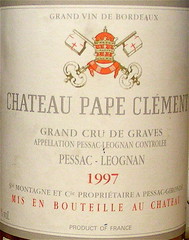 Our last white was the 1997 Château Pape Clément Blanc. Château Pape Clément is one of the most ancient estates in Bordeaux. One of its original owners, Bertrand de Goth, was elected Pope Clément V in 1305. He was the first of seven Popes to rule from Avignon. He was also the one that established the Pope's country residence and named it Châteauneuf-du-Pape. The white wine, a blend of 45% Sauvignon Blanc 45% Sémillon 10% Muscadelle, represents only 10% of the total production. Unfortunately, the wine that we tasted was oxidized. It displayed a pretty amber color but on the nose, it had unpleasant cheesy and sherry-like aromas.
Our last white was the 1997 Château Pape Clément Blanc. Château Pape Clément is one of the most ancient estates in Bordeaux. One of its original owners, Bertrand de Goth, was elected Pope Clément V in 1305. He was the first of seven Popes to rule from Avignon. He was also the one that established the Pope's country residence and named it Châteauneuf-du-Pape. The white wine, a blend of 45% Sauvignon Blanc 45% Sémillon 10% Muscadelle, represents only 10% of the total production. Unfortunately, the wine that we tasted was oxidized. It displayed a pretty amber color but on the nose, it had unpleasant cheesy and sherry-like aromas.
Tasting the red wines
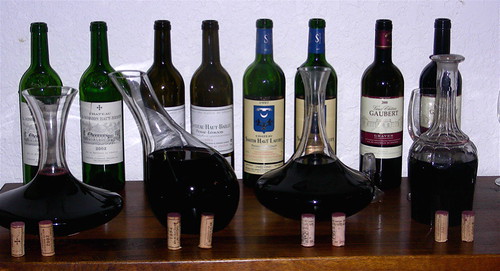
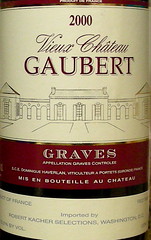 Our first red wine was the 2000 Vieux Château Gaubert Rouge, a blend of Cabernet Sauvignon, Merlot, and Cabernet Franc. I found the wine very pleasant with a red fruit nose, peppery aromas, a smooth palate and a well-balanced finish.
Our first red wine was the 2000 Vieux Château Gaubert Rouge, a blend of Cabernet Sauvignon, Merlot, and Cabernet Franc. I found the wine very pleasant with a red fruit nose, peppery aromas, a smooth palate and a well-balanced finish.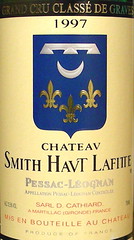 The next wine was the 1997 Château Smith Haut Lafitte. The vineyard of Château Smith Haut Lafitte is planted with 55% Cabernet Sauvignon, 35% Merlot, 10% Cabernet Franc for the red wine, a classified growth in the Graves classification, and 95% Sauvignon Blanc, 5% Sémillon for the white wine. I really enjoyed this wine, which was my favorite red wine. The nose was full of dark fruits, chocolate and coffee. On the palate, it was full-bodied and tasty with a long finish.
The next wine was the 1997 Château Smith Haut Lafitte. The vineyard of Château Smith Haut Lafitte is planted with 55% Cabernet Sauvignon, 35% Merlot, 10% Cabernet Franc for the red wine, a classified growth in the Graves classification, and 95% Sauvignon Blanc, 5% Sémillon for the white wine. I really enjoyed this wine, which was my favorite red wine. The nose was full of dark fruits, chocolate and coffee. On the palate, it was full-bodied and tasty with a long finish.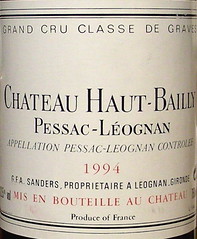 Then, we tasted the 1994 Château Haut-Bailly. The Château Haut-Bailly, another classified growth and one of the few properties that cultivates red varietals only. The Haut-Bailly vineyard consists of 65% Cabernet Sauvignon, 25% Merlot, 10% Cabernet Franc, and finally 15% still planted with vines on pre-phylloxera French rootstock. This means that there are still many plants of Carmenère, Malbec and Petit Verdot in the vineyard, as it was common in Bordeaux in the 19th century. The wine had a red fruit nose, nice cocoa powder flavors, and a lighter-bodied palate than the Smith Haut Lafitte. For many guests, this was their favorite red wine.
Then, we tasted the 1994 Château Haut-Bailly. The Château Haut-Bailly, another classified growth and one of the few properties that cultivates red varietals only. The Haut-Bailly vineyard consists of 65% Cabernet Sauvignon, 25% Merlot, 10% Cabernet Franc, and finally 15% still planted with vines on pre-phylloxera French rootstock. This means that there are still many plants of Carmenère, Malbec and Petit Verdot in the vineyard, as it was common in Bordeaux in the 19th century. The wine had a red fruit nose, nice cocoa powder flavors, and a lighter-bodied palate than the Smith Haut Lafitte. For many guests, this was their favorite red wine.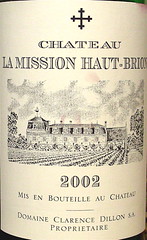 We finished the tasting with the 2002 Château La Mission Haut-Brion. The Château La Mission Haut-Brion property is planted with 48% Cabernet Sauvignon, 45% Merlot and 7% Cabernet Franc and lies on the opposite side of the road from Haut-Brion. For several decades, La Mission had been Haut-Brion's direct rival until the Dillon family of Haut-Brion acquired the property in 1983. Compared with Haut-Brion, La Mission tends to produce bigger and richer wines. The 2002 that we tasted was powerful indeed with smoky and chocolate aromas on the nose. It had a young and tannic palate with notes of crème brulée, followed by a vivid, lengthy finish.
We finished the tasting with the 2002 Château La Mission Haut-Brion. The Château La Mission Haut-Brion property is planted with 48% Cabernet Sauvignon, 45% Merlot and 7% Cabernet Franc and lies on the opposite side of the road from Haut-Brion. For several decades, La Mission had been Haut-Brion's direct rival until the Dillon family of Haut-Brion acquired the property in 1983. Compared with Haut-Brion, La Mission tends to produce bigger and richer wines. The 2002 that we tasted was powerful indeed with smoky and chocolate aromas on the nose. It had a young and tannic palate with notes of crème brulée, followed by a vivid, lengthy finish.Many thanks to Arnaud for another great tasting and to Marie-Christine and Edouard for sharing their house!
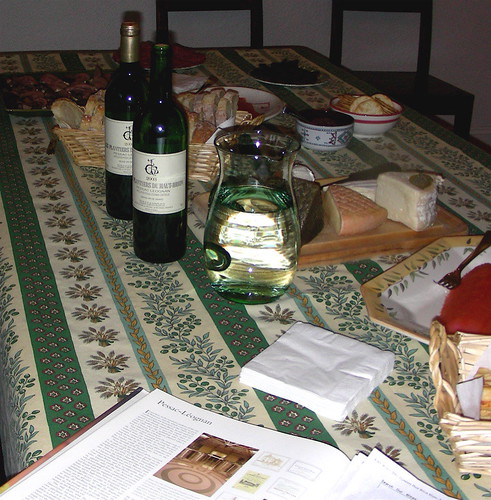
Technorati tags: wine food & drink
No comments:
Post a Comment